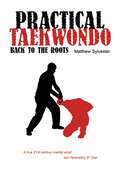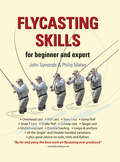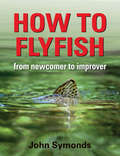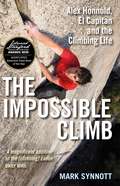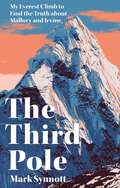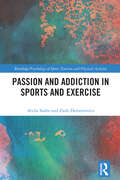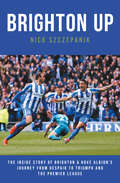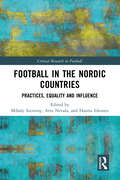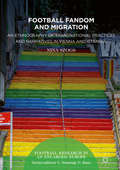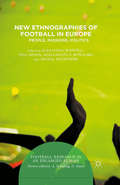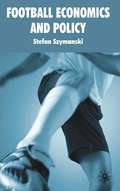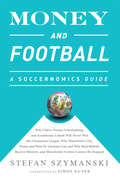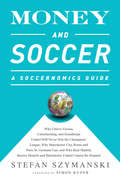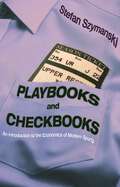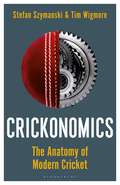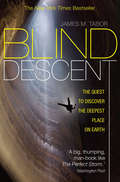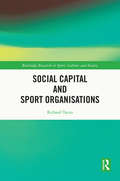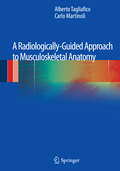- Table View
- List View
Practical Taekwondo: Back to the Roots
by Matthew SylvesterWith over 500 photos and step-by-step instructions, Practical Taekwondo offers a wealth of interpretations of ITF and WTF taekwondo patterns. Packed with information that will make your training practical and relevant to the social challenges of the twenty-first century, this book will help you look at patterns in a totally different way.
Flycasting Skills: For Beginner and Expert
by John SymondsWith the help of expert casting instructors Symonds and Maher, you can now become a master of the flyrod. Whatever your present abilities, this book will leave you with the perfect casting skills for all situations. Flycasting, that key pre-requisite to all successful trout and salmon fishing, can be a stumbling block for many anglers. This clear, well-illustrated guidebook will show you, step-by-step, how to execute all the casts you will ever need: from basic Overhead cast to Double-handed Spey cast, and from the simple Roll cast to the flamboyant Snake cast, and many more. Packed with useful tips on: • which cast to use and when • how to improve your casting techniques • how to correct bad habits • latest casts from around the world • advice on best casting rods, reels and flylines This book will transform your casting skills whether you are a complete beginner or an already experienced flyfisher.
How to Flyfish: From Newcomer to Improver
by John SymondsIn this clear and attractive book are all the essential skills you need to be a competent all-round flyfisher. With John Symonds you will learn how to fish for trout and salmon in stillwaters from both bank and boat; in rivers; dry fly and wet fly. You will know how to tie reliable and easy knots, to construct the right leaders, learn where the fish are most likely to lie, how to cast to them and which flies to use. How to Flyfish will bring you up-to-date with all the latest on leader construction and knots, boat control with the paradrogue, traditional nymphing methods to the popular tenkara style. Packed with useful tips and clear diagrams.
The Impossible Climb: Alex Honnold, El Capitan and the Climbing Life
by Mark SynnottIf you loved watching Free Solo, you'll be enthralled by Mark Synnott's deeply reported, insider perspective on Alex Honnold's impossible climb.One slip, one false move, one missed toehold and you're dead. On June 3rd 2017 Mark Synnott was in Yosemite to witness something that only a handful of people knew was about to occur: the most famous climber in the world, Alex Honnold, was going to attempt to summit one of the world's most challenging ascents, a route called Freerider on the notorious rock formation El Capitan. It is a climb extraordinarily dangerous and difficult, and yet Honnold was going to do it 'free solo'. Meaning no help. No climbing partner. No equipment. No rope. Where a single small mistake would mean certain death. Indeed, to summit El Cap free solo was a feat likened to Neil Armstrong first walking on the moon. In The Impossible Climb, Mark Synnott uses his own career as a professional climber to paint an insider portrait of the elite climbing community, exploring what motivates them, the paradoxical drive to keep the sport pure and at the same time to fund climbs, and the role that awareness of mortality plays in the endeavour. We watch through Mark's eyes as Alex plots, trains and attempts his heart-stopping free-solo ascent. Ultimately this is a story not only about climbing but about what makes us human, how we respond to fear and our drive to transcend the inevitability of death.
The Third Pole: My Everest climb to find the truth about Mallory and Irvine
by Mark SynnottVeteran climber Mark Synnott never planned on climbing Mount Everest, but a hundred-year mystery lured him into an expedition--and an awesome history of passionate adventure, chilling tragedy, and human aspiration unfolded.On June 8, 1924, George Mallory and "Sandy" Irvine set out to stand on the roof of the world, where no one had stood before. They were last seen eight hundred feet shy of Everest's summit. A century later, we still don't know whether they achieved their goal, decades before Sir Edmund Hillary and Tensing Norgay did, in 1953. Irvine carried a Kodak camera with him to record their attempt, but it, along with his body, had never been found. Did Mallory and Irvine reach the summit and take a photograph before they fell to their deaths?Mark Synnott made his own ascent up the infamous North Face along with a filmmaker using drone technology higher than any had previously flown. His goal: to find Irvine's body and the camera he carried that might have held a summit photo on its still-viable film. Synnott's quest led him from oxygen-deprivation training to archives and museums in England, to Kathmandu, the Tibetan High Plateau, and up the North Face into a storm during a season described as the one that broke Everest. An awful traffic jam of climbers at the very summit resulted in tragic deaths. Sherpas revolted. Chinese government agents turned adversarial. An Indian woman crawled her way to safety and survival. Synnott himself went off the safety rope--if he had slipped, no one would have been able to save him--desperate to solve the mystery.A magnificent story a la The Lost City of Z, The Third Pole conveys the miracle of a mountain the world wants to own, and the first explorers who may have done so.
Passion and Addiction in Sports and Exercise (Routledge Psychology of Sport, Exercise and Physical Activity)
by Attila Szabo Zsolt DemetrovicsPassion and Addiction in Sports and Exercise is about the bright and dark aspects of sports and exercise behavior and revolves around two closely related yet distinct concepts. Passion is a joyful and healthy reflection of one’s enjoyment and dedication to an adopted sport or exercise. At the same time, exercise addiction is an obligatory and must-be-done training regimen. This book is the first to attempt to explain the significant differences between passion and addiction in sports and exercise. This book presents an overview of three dimensions of passion and offers a new frame to contextualize exercise addition. The work also addresses the misinterpretation of certain aspects of training (e.g., intensity, frequency, commitment) often related to addiction. After introducing the health benefits of exercise, the book looks at the passion for sports and exercise training and the transition into maladaptive practice. Then it presents definitions and theoretical models for exercise addiction. It then examines exercise addiction cases while also illustrating how excessive or high exercise volumes are beneficial instead of problematic. The last chapter offers a new approach for a better understanding of exercise addiction. Passion and Addiction in Sports and Exercise is helpful for students, researchers, and clinicians interested in sport and exercise psychology, athletic training, behavioral addictions, and physical
Passion and Addiction in Sports and Exercise (Routledge Psychology of Sport, Exercise and Physical Activity)
by Attila Szabo Zsolt DemetrovicsPassion and Addiction in Sports and Exercise is about the bright and dark aspects of sports and exercise behavior and revolves around two closely related yet distinct concepts. Passion is a joyful and healthy reflection of one’s enjoyment and dedication to an adopted sport or exercise. At the same time, exercise addiction is an obligatory and must-be-done training regimen. This book is the first to attempt to explain the significant differences between passion and addiction in sports and exercise. This book presents an overview of three dimensions of passion and offers a new frame to contextualize exercise addition. The work also addresses the misinterpretation of certain aspects of training (e.g., intensity, frequency, commitment) often related to addiction. After introducing the health benefits of exercise, the book looks at the passion for sports and exercise training and the transition into maladaptive practice. Then it presents definitions and theoretical models for exercise addiction. It then examines exercise addiction cases while also illustrating how excessive or high exercise volumes are beneficial instead of problematic. The last chapter offers a new approach for a better understanding of exercise addiction. Passion and Addiction in Sports and Exercise is helpful for students, researchers, and clinicians interested in sport and exercise psychology, athletic training, behavioral addictions, and physical
Brighton Up
by Nick SzczepanikBrighton Up: The Inside Story of Brighton & Hove Albion's Journey From Despair to Triumph and the Premier League tells the story of how Brighton & Hove Albion Football Club bounced back from the heartbreak of missing out on promotion to the Premier League by the narrowest of margins, to achieve that ultimate goal earlier this month. Acclaimed sports journalist Nick Szczepanik, a lifelong Brighton fan with strong contacts at the club, documents its travails over two turbulent seasons.The book explains how the Seagulls, written off as certainties for relegation to League One before the 2015-16 season, overcame the loss of one of their own in the Shoreham Air Show tragedy to go on a record unbeaten run. But although top scorers in the Championship, they fell agonisingly short of their target of automatic promotion by a single goal, then lost out again in the lottery of the play-offs.The football world expected them to be crushed by disappointment and outspent by the big guns of Newcastle, Norwich and Aston Villa, but instead they regrouped and came back stronger in 2016-17.Led by experienced and inscrutable manager Chris Hughton and backed by owner Tony Bloom - the world-class poker player nicknamed 'The Lizard' for his ice-cold blood - they played with a determination not to let the heartbreak happen again.
Football in the Nordic Countries: Practices, Equality and Influence (Critical Research in Football)
by Mihaly Szerovay Arto Nevala Hannu ItkonenThis book explores football culture, organisation and development in the five Nordic countries: Denmark, Finland, Iceland, Sweden and Norway. These countries represent an important case study in sport culture, policy and management, being shaped by unique traditions in their civil society and in social welfare and public policy. The first part of the book explores the development path of football in each country, looking at how football arrived in Scandinavia and how it has been transformed from a voluntary civic activity into a professional sport while becoming closely attached to the global football system. The second part highlights key issues – including historical, contemporary and critical aspects – across three themes: professionalisation and changing practices; equality and gender; and supporters, audiences and culture. Written by a team of authors with a blend of experience as academics and practitioners in football, the book traces the contours of the distinctive Nordic model that occupies a prominent position in the global football system. Shining fascinating new light on the relationship between football and wider society, this is invaluable reading for students and researchers interested in football, sport management, sport policy, or the history, culture or sociology of sport and for anyone involved in the game.
Football in the Nordic Countries: Practices, Equality and Influence (Critical Research in Football)
by Mihaly Szerovay Arto Nevala Hannu ItkonenThis book explores football culture, organisation and development in the five Nordic countries: Denmark, Finland, Iceland, Sweden and Norway. These countries represent an important case study in sport culture, policy and management, being shaped by unique traditions in their civil society and in social welfare and public policy. The first part of the book explores the development path of football in each country, looking at how football arrived in Scandinavia and how it has been transformed from a voluntary civic activity into a professional sport while becoming closely attached to the global football system. The second part highlights key issues – including historical, contemporary and critical aspects – across three themes: professionalisation and changing practices; equality and gender; and supporters, audiences and culture. Written by a team of authors with a blend of experience as academics and practitioners in football, the book traces the contours of the distinctive Nordic model that occupies a prominent position in the global football system. Shining fascinating new light on the relationship between football and wider society, this is invaluable reading for students and researchers interested in football, sport management, sport policy, or the history, culture or sociology of sport and for anyone involved in the game.
Football Fandom and Migration: An Ethnography of Transnational Practices and Narratives in Vienna and Istanbul
by Nina SzogsThis book studies how transnationalisation, Europeanisation and migration processes intersect with football fandom, through an analysis of the transnational narratives and practices of Fenerbahçe and Galatasaray football fans in Vienna, Austria. Based on ethnographic fieldwork in Austria, Turkey and Germany, the author analyses the ways in which narratives about football fandom are often linked to migrant experiences, including practices of (self‑)culturalization in the diasporic context in Austria. The book shows how constructed ethnicities and also masculinities and femininities meet in football fan performances and in the construction of what makes a “proper” football fan. Turkish football fandom is a field where powerful prejudices and stereotypes amalgamate and interact. This study enables the reader to look into migration processes and discussions about related topics from a different angle: the love of a football club. Football Fandom and Migration will be of interest to students and scholars across a range of disciplines, including anthropology, sociology, European studies, political sciences, gender studies, leisure studies, sport sociology and history.
Football Fandom and Migration: An Ethnography of Transnational Practices and Narratives in Vienna and Istanbul
by Nina SzogsThis book studies how transnationalisation, Europeanisation and migration processes intersect with football fandom, through an analysis of the transnational narratives and practices of Fenerbahçe and Galatasaray football fans in Vienna, Austria. Based on ethnographic fieldwork in Austria, Turkey and Germany, the author analyses the ways in which narratives about football fandom are often linked to migrant experiences, including practices of (self‑)culturalization in the diasporic context in Austria. The book shows how constructed ethnicities and also masculinities and femininities meet in football fan performances and in the construction of what makes a “proper” football fan. Turkish football fandom is a field where powerful prejudices and stereotypes amalgamate and interact. This study enables the reader to look into migration processes and discussions about related topics from a different angle: the love of a football club. Football Fandom and Migration will be of interest to students and scholars across a range of disciplines, including anthropology, sociology, European studies, political sciences, gender studies, leisure studies, sport sociology and history.
New Ethnographies of Football in Europe: People, Passions, Politics (Football Research in an Enlarged Europe)
by Nina Szogs Alexandra Schwell Malgorzata Z. Kowalska Michal BuchowskiFootball has emerged as an important symbolic field through which various social, cultural, political, economic, and historical dimensions and antagonisms are negotiated. This volume covers a variety of themes illuminating the multiple ways that football impacts on people's everyday lives. Using anthropological research methods and data collected from ethnographic fieldwork, the contributors scrutinize not only the social fields of football fans and the specific socio-cultural contexts in which they are embedded, but also other actors beyond the pitch, and the possibilities for both agency and subversion. Taking into account processes of Europeanization, globalization, commercialization and migration, the collection offers fresh insights into fan identity formations and practices and highlights the importance of anthropology's self-reflexive and actor-centred perspective.
Football Economics and Policy
by S. SzymanskiThis volume deals with the competitive structure of football. It examines the relationship between sporting success and economic variables, the structure of European competitions, financial problems in football, their origins and options for reform, racial discrimination in English football, and the economic impact of the World Cup.
Money and Football (INTL ed): Why Chievo Verona, Unterhaching, and Scunthorpe United Will Never Win the Champions League, Why Manchester City, Roma, and Paris St. Germain Can, and Why Real Madrid, Bayern Munich, and Manchester United Cannot Be Stopped
by Stefan SzymanskiModern soccer is big business. From the ill-received takeover of Manchester United by the Glazer family to Paris Saint Germain's current shopping spree for the best footballers on the planet, soccer finance has become an increasingly important part of the game.Barely a summer goes by now without a cherished club going into administration or a wealthy businessman funding a mid table team's ascension to Champions League competitor. Meanwhile, the twice-annual multi-million dollar merry-go-round of transfer season sees players (and now managers) signed for sums thought impossible just a decade ago. Understanding soccer finance has become essential for comprehending the beautiful game. But for many fans, soccer finance remains, frustratingly, a world that is opaque and difficult to grasp.Stefan Szymanski, co-author of the bestselling Soccernomics, tackles every soccer fan's burning questions in Money and Soccer: A Soccernomics Guide. From the abolition of the maximum wage in the 1960s, through to the impact of TV money both at home and abroad in the 1990s and 2000s, Szymanski explains how money, or lack of, affects your favorite club. Drawing on extensive research into financial records dating back to the 1970s, Szymanski provides clear analysis of the way that clubs have transformed in the modern era.This book isn't limited to European clubs. Szymanski, a renowned expert on sports management and economics, looks at what we can learn from comparing the ascension of Europe's biggest clubs to their lofty perches and with new financial models across the world. Through careful research and informative stories drawn from around the globe, Szymanski provides an accessible guide to the world of soccer finance.
Money and Soccer: Why Chievo Verona, Unterhaching, and Scunthorpe United Will Never Win the Champions League, Why Manchester City, Roma, and Paris St. Germain Can, and Why Real Madrid, Bayern Munich, and Manchester United Cannot Be Stopped
by Stefan SzymanskiModern soccer is big business. From the ill-received takeover of Manchester United by the Glazer family to Paris Saint Germain's current shopping spree for the best footballers on the planet, soccer finance has become an increasingly important part of the game. Barely a summer goes by now without a cherished club going into administration or a wealthy businessman funding a mid table team's ascension to Champions League competitor. Meanwhile, the twice-annual multi-million dollar merry-go-round of transfer season sees players (and now managers) signed for sums thought impossible just a decade ago. Understanding soccer finance has become essential for comprehending the beautiful game. But for many fans, soccer finance remains, frustratingly, a world that is opaque and difficult to grasp. Stefan Szymanski, co-author of the bestselling Soccernomics, tackles every soccer fan's burning questions in Money and Soccer: A Soccernomics Guide. From the abolition of the maximum wage in the 1960s, through to the impact of TV money both at home and abroad in the 1990s and 2000s, Szymanski explains how money, or lack of, affects your favorite club. Drawing on extensive research into financial records dating back to the 1970s, Szymanski provides clear analysis of the way that clubs have transformed in the modern era. This book isn't limited to European clubs. Szymanski, a renowned expert on sports management and economics, looks at what we can learn from comparing the ascension of Europe's biggest clubs to their lofty perches and with new financial models across the world. Through careful research and informative stories drawn from around the globe, Szymanski provides an accessible guide to the world of soccer finance.
Playbooks and Checkbooks: An Introduction to the Economics of Modern Sports
by Stefan SzymanskiWhat economic rules govern sports? How does the sports business differ from other businesses? Playbooks and Checkbooks takes a fascinating step-by-step look at the fundamental economic relationships shaping modern sports. Focusing on the ways that the sports business does and does not overlap with economics, the book uncovers the core paradox at the heart of the sports industry. Unlike other businesses, the sports industry would not survive if competitors obliterated each other to extinction, financially or otherwise--without rivals there is nothing to sell. Playbooks and Checkbooks examines how this unique economic truth plays out in the sports world, both on and off the field. Noted economist Stefan Szymanski explains how modern sporting contests have evolved; how sports competitions are organized; and how economics has guided antitrust, monopoly, and cartel issues in the sporting world. Szymanski considers the motivation provided by prize money, uncovers discrepancies in players' salaries, and shows why the incentive structure for professional athletes encourages them to cheat through performance-enhancing drugs and match fixing. He also explores how changes in media broadcasting allow owners and athletes to play to a global audience, and why governments continue to publicly fund sporting events such as the Olympics, despite almost certain financial loss. Using economic tools to reveal the complex arrangements of an industry, Playbooks and Checkbooks illuminates the world of sports through economics, and the world of economics through sports.
Playbooks and Checkbooks: An Introduction to the Economics of Modern Sports
by Stefan SzymanskiWhat economic rules govern sports? How does the sports business differ from other businesses? Playbooks and Checkbooks takes a fascinating step-by-step look at the fundamental economic relationships shaping modern sports. Focusing on the ways that the sports business does and does not overlap with economics, the book uncovers the core paradox at the heart of the sports industry. Unlike other businesses, the sports industry would not survive if competitors obliterated each other to extinction, financially or otherwise--without rivals there is nothing to sell. Playbooks and Checkbooks examines how this unique economic truth plays out in the sports world, both on and off the field. Noted economist Stefan Szymanski explains how modern sporting contests have evolved; how sports competitions are organized; and how economics has guided antitrust, monopoly, and cartel issues in the sporting world. Szymanski considers the motivation provided by prize money, uncovers discrepancies in players' salaries, and shows why the incentive structure for professional athletes encourages them to cheat through performance-enhancing drugs and match fixing. He also explores how changes in media broadcasting allow owners and athletes to play to a global audience, and why governments continue to publicly fund sporting events such as the Olympics, despite almost certain financial loss. Using economic tools to reveal the complex arrangements of an industry, Playbooks and Checkbooks illuminates the world of sports through economics, and the world of economics through sports.
Crickonomics: The Anatomy of Modern Cricket
by Stefan Szymanski Tim WigmoreAn engaging tour of the modern game from an award-winning journalist and the economist who co-authored the bestselling Soccernomics. Why does England rely on private schools for their batters – but not their bowlers? How did demographics shape India's rise? Why have women often been the game's great innovators? Why does South Africa struggle to produce Black Test batters? And how does the weather impact who wins? Crickonomics explores all of this and much more – including how Jayasuriya and Gilchrist transformed Test batting but T20 didn't; English cricket's great missed opportunity to have a league structure like football; why batters are paid more than bowlers; how Afghanistan is transforming German cricket; what the rest of the world can learn from New Zealand and even the Barmy Army's importance to Test cricket. This incisive book will entertain and surprise all cricket lovers. It might even change how you watch the game.
Crickonomics: The Anatomy of Modern Cricket
by Stefan Szymanski Tim WigmoreAn engaging tour of the modern game from an award-winning journalist and the economist who co-authored the bestselling Soccernomics. Why does England rely on private schools for their batters – but not their bowlers? How did demographics shape India's rise? Why have women often been the game's great innovators? Why does South Africa struggle to produce Black Test batters? And how does the weather impact who wins? Crickonomics explores all of this and much more – including how Jayasuriya and Gilchrist transformed Test batting but T20 didn't; English cricket's great missed opportunity to have a league structure like football; why batters are paid more than bowlers; how Afghanistan is transforming German cricket; what the rest of the world can learn from New Zealand and even the Barmy Army's importance to Test cricket. This incisive book will entertain and surprise all cricket lovers. It might even change how you watch the game.
Blind Descent: The Quest to Discover the Deepest Place on Earth
by James M. TaborThe deepest cave on earth was a prize that had remained unclaimed for centuries, long after every other ultimate discovery had been made. This is the story of the men and women who risked everything to find it, earning their place in history beside the likes of Peary, Amundsen, Hillary, and Armstrong.In 2004, two great scientist-explorers attempted to find the bottom of the world. Bold, American Bill Stone was committed to the vast Cheve Cave, located in southern Mexico and deadly even by supercave standards. On the other side of the globe, legendary Ukrainian explorer Alexander Klimchouk - Stone's opposite in temperament and style - had targeted Krubera, a freezing nightmare of a supercave in the Republic of Georgia.Blind Descent explores both the brightest and darkest aspects of the timeless human urge to discover - to be first. It is also a thrilling epic about a pursuit that makes even extreme mountaineering and ocean exploration pale by comparison. These supercavers spent months in multiple camps almost two vertical miles deep and many more miles from their caves' exits. They had to contend with thousand-foot drops, deadly flooded tunnels, raging whitewater rivers, monstrous waterfalls, mile-long belly crawls, and much more. Perhaps even worse were the psychological horrors produced by weeks plunged into absolute, perpetual darkness, beyond all hope of rescue, including a particularly insidious derangement called 'The Rapture'.Blind Descent is a testament to human survival and endurance - and to two extraordinary men whose relentless pursuit of greatness led them to heights of triumph and depths of tragedy neither could have imagined.
Social Capital and Sport Organisations (Routledge Research in Sport, Culture and Society)
by Richard TaconDrawing on primary research within voluntary sports clubs in the UK and secondary analysis of the wider international literature on social capital, this text focuses on the micro-processes of social capital development and how they play out in specific social settings. In so doing, it adds to existing research by developing a rich, contextualised, process-based view of social capital in action. Critically reviewing theoretical and empirical literature on social capital, the book highlights the key current debates. The empirical core of the book draws on ethnographic observation over 18 months at voluntary sports clubs in the UK, including in-depth interviews with sports club members and organisers. The text explicitly seeks to set this empirical work in its wider context, by considering the findings in relation to other international studies of social capital in both sports clubs and other types of organisation. The book draws on international research from a whole range of countries: UK, USA, Australia, Canada, Norway, Denmark, Netherlands, Japan, Vanuatu, Czech Republic, Germany, and many others. The book establishes a transferable, process-based understanding of how social capital develops – both within sports clubs and beyond. This is an illuminating reading for policymakers, practitioners, and researchers with an interest in the sociology of sport, sport development, sport management, sport policy, social theory, social policy, or social networks.
Social Capital and Sport Organisations (Routledge Research in Sport, Culture and Society)
by Richard TaconDrawing on primary research within voluntary sports clubs in the UK and secondary analysis of the wider international literature on social capital, this text focuses on the micro-processes of social capital development and how they play out in specific social settings. In so doing, it adds to existing research by developing a rich, contextualised, process-based view of social capital in action. Critically reviewing theoretical and empirical literature on social capital, the book highlights the key current debates. The empirical core of the book draws on ethnographic observation over 18 months at voluntary sports clubs in the UK, including in-depth interviews with sports club members and organisers. The text explicitly seeks to set this empirical work in its wider context, by considering the findings in relation to other international studies of social capital in both sports clubs and other types of organisation. The book draws on international research from a whole range of countries: UK, USA, Australia, Canada, Norway, Denmark, Netherlands, Japan, Vanuatu, Czech Republic, Germany, and many others. The book establishes a transferable, process-based understanding of how social capital develops – both within sports clubs and beyond. This is an illuminating reading for policymakers, practitioners, and researchers with an interest in the sociology of sport, sport development, sport management, sport policy, social theory, social policy, or social networks.
Her Ladyship’s Guide to the British Season: The Essential Practical And Etiquette Guide (Ladyship's Guides)
by Caroline TaggartA Radiologically-Guided Approach to Musculoskeletal Anatomy
by Alberto Tagliafico Carlo MartinoliFor many healthcare professionals, musculoskeletal diseases represent the "bread and butter" topic after graduation. Therefore, radiological education in respect of the musculoskeletal system is vital in ensuring adequate patient management and cost-effective use of healthcare financial resources. This book illustrates the clinical anatomy of the musculoskeletal system by means of images obtained using commercially available imaging equipment and the three main imaging techniques employed today – magnetic resonance imaging, computed tomography, and ultrasound. Based on an integrated multimodality approach, each anatomical region is presented with a special focus on clinically relevant anatomical details and the characteristic findings observed in patients referred by physicians. With almost 450 images and illustrations, A Radiologically Guided Approach to Musculoskeletal Anatomy is intended as a bridge from a standard anatomical atlas to diagnostic imaging. It will assist in the everyday interpretation of imaging studies of the musculoskeletal system, providing prompt answers to frequently encountered questions. Clinical notes and self-assessment modules are also provided. All who wish to learn more about the role of diagnostic imaging of the musculoskeletal system will find this book to be of great value. It will benefit not only medical students and residents but also radiology technologists and professionals in other fields of health care, including orthopaedists, rheumatologists, and rehabilitation specialists.
